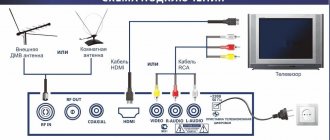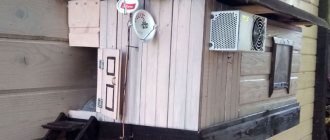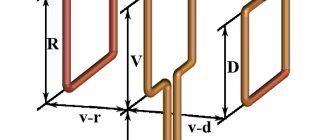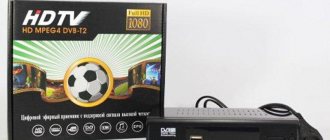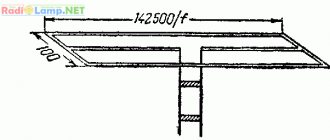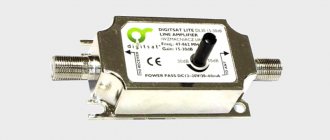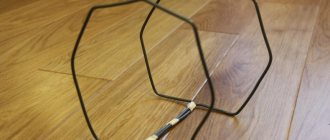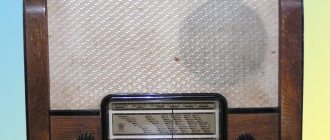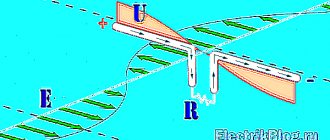Do you want to start watching T2 digital television in your country house? You will need the right antenna to receive DVB T2 digital television at your dacha. Don’t know which one to install, are there problems and uncertainties with digital television outside the city? This article is for you, because an antenna is the most effective, best way to solve these problems, and very often the only one.
If your digital television reception turns out to be poor, and you do not have practical experience to ensure good reception, then read the article carefully, and most importantly, try to follow the recommendations you have read.
Types of antennas
What is the most important thing for confident, stable reception of digital television? Antenna. It doesn’t matter where your country estate is located, to receive a digital signal you will have to work hard when choosing a television antenna for your dacha. There is no job more stupid and unnecessary than trying to receive a digital signal outside the city with an indoor antenna. Only the lucky ones will be able to watch digital television on an indoor antenna without any problems, and only if it is located in an area of reliable reception, near a TV tower or repeater.
Modern requirements
- Previously, the decisive importance was given to the coefficients of directional and protective action. This is not the case now. The airwaves have become heavily polluted, and it is necessary to overcome the interference by electronic means;
- The individual antenna gain comes first. Such a UHF antenna can create the necessary margin of safety for the signal, which will subsequently be processed by electronics;
- It is important to ensure the smoothness of the amplitude-frequency response. Sharp peaks and valleys will cause phase distortion;
- Coordination with the cable over the entire frequency range must be complete without the use of additional devices;
- The antenna parameters must meet the requirements over the entire frequency range initially. The band antenna does not need to be artificially adapted using engineering tricks.
4g antenna
DIY antenna
Active and passive analog antennas
The antenna for a TV in the country can be active or passive. If a traditional external one has a box into which the antenna cable goes, and the box itself contains a matching board (balun), then it is passive. If you are using a garden antenna with an amplifier to which power is supplied, then it is of the active type.
Power supply for amplification board 12 V 0.5 A
Antenna for receiving digital television in the country
It's time to find out that a digital antenna for a summer residence is a marketing fiction. There are no “digital antennas”, “digital cables”, “digital amplifiers”. There are over-the-air antennas, coaxial cables, and antenna amplifiers. Their parameters and cost do not correlate in any way with either digital or analogue TV standards.
A special antenna for digital is an advertising scam. For digital TV in the country, ordinary decimeter (UHF) or broadband antennas (MF-UHF) are suitable.
And yet, what kind of antenna should I put in my dacha for long-distance reception? Multi-director at the highest possible height, precisely aimed at the broadcast tower, will give the best result. As a general rule, longer antennas with more bars (these bars are called "directors") provide much better reception than shorter ones.
Long range antenna
TV signal parameters
Level is an indicator of how strong the digital television signal is at the tuner input. The level is not determined by you or its seller. In the menu of any terrestrial digital tuner there is a function that shows you the signal strength.
You may be interested in: Plan to switch off analogue television in Russia
Quality is the main indicator for which you will have to tinker with the antenna. It shows how suitable a TV signal is for digital decoding without errors. The digital tuner calculates the quality itself and can show it to you through its menu.
Signal level on the set-top box
Having set the frequency of the multiplex you need, you will see the level and quality of the signal graphically displayed on the TV screen. And then, by turning your antenna in different directions, and also installing it in different places, you can evaluate how these parameters change.
It is extremely important to correctly place the antenna in the country house. 1-2 meters in any direction and the reception can change a lot. The higher the antenna is located, the better. The further away from large metal objects, the better.
Beer can antenna
Ether antenna devices can be created from many simple materials that are used in household use, even from ordinary cans in which carbonated drinks are sold. Such a mini-receiver will not be very powerful, but you can pick up about 7 channels, not only in the UHF range, but also in the longer one - VHF.
There is one important condition: the cans must be smooth, not ridged, clean and dry. The essence of this design is very simple: you just need to solder 2 cans to the cable and place them on opposite sides on a wooden base.
The number of cans can be used differently; it is believed that it is optimal to create 3 or 4 lines of cans, since 1-2 lines pick up the signal weakly, and more than 5 lines are difficult to coordinate. In addition to cans, you need to prepare the following materials:
- About 5 meters of ordinary TV cable marked “RK-75”;
- Wooden or plastic base structure;
- Several self-tapping screws, electrical tape, and a soldering iron.
First you need to prepare the TV cable: step back 10 cm from the edge, make a shallow cut and remove the top layer of insulation. Carefully twist the inner braided screen into a single bundle. On the same side of the cable, remove the plastic insulation and expose the central core. A plug must be connected to the opposite end of the cable.
Next, we will need to connect the coaxial cable to the banks. To do this, it is better to use small flea screws for drywall: screw a twisted cable braid to one can, and a copper core to the second can. For better contact, connections can be soldered.
Now you should secure the cans to a wooden base plate. This can be done using ordinary adhesive tape, electrical tape or a glue gun; you can even use an ordinary clothes hanger or any flat structure at hand. The main thing is that the metal cans are of the same shape, the same size (volume) and are located strictly on the same line. The distance between the sheet metal elements, as well as the location of the antenna installation, is selected experimentally.
You can improve the design by creating a grid of several lines with banks, and if there is such an opportunity, then connect an amplifier. If a homemade antenna made from beer cans is placed on the street, then its elements will have to be hidden in larger plastic bottles.
The length of the cable affects the signal attenuation: the longer the cord, the more the on-air transmission is attenuated. This is especially true for receiving meter waves.
Reasons for signal deterioration
What should you do and what not to do in order to receive a more or less high-quality digital signal and not degrade it?
First, do what you need to do to get the best possible antenna signal. A high-quality, narrowly directional antenna for a TV in the countryside is placed further and higher from large metal objects. It is advisable that there are no very high obstacles on the imaginary line from the antenna to the television transmitter: hills, waste heaps, tall trees. Install your antenna away from the iron roof of your country house, and in no case - under the iron roof itself, then there is guaranteed to be no digital television reception.
To avoid degrading the received signal, lay the cable correctly:
- don't use the cable you bought when your grandfather went to first grade;
- Don't buy the cheapest cable with virtually no braid. Choose normal cables;
- Do not shorten the cable as much as possible;
- do not make sharp bends in the cable;
- Do not twist the excess cable into a coil.
Even if you connect pieces of cable with a standard coaxial connector, the signal quality is guaranteed to deteriorate.
You can see how to strip the cable here.
Materials and calculations
How and from what items and materials can you make an antenna at home? Let's look at the TOP 5 most interesting options:
- Powerful coaxial cable antenna;
- All-wave antenna made of wire;
- "Butterfly";
- "Eight" or zigzag;
- Antenna made from beer cans.
A tube, rod or wire made of copper or aluminum are excellent materials for making an antenna. They are flexible, bend well and hold their shape well. You can use any conductive metal products: wires, corners, rods, strips, etc.
Coaxial cable has the same properties as copper cable, but is much cheaper, and, in addition, coaxial is also mechanically strong, which is important for antenna design. To save money, you can use pieces of wire that are available in your household or buy them in the hardware store.
First of all, let's decide on the size of the antenna. The antenna cable length (L) is calculated depending on the broadcast frequency. To calculate we need two values:
- The speed of wave propagation in vacuum is ≈ 300 million m/s;
- F - reception frequency (digital TV signal frequencies are usually in the range of 500-800 MHz).
If we take the frequency parameter in MHz, then the desired wavelength value will be in meters. The calculated speed of light parameter is 300. The wavelength in the cable can be calculated using a simple formula:
L = 300/F
Calculation example: let digital broadcasting be carried out at an average frequency of 610.5 MHz. Then the average wavelength = 300/610.5 = 0.491 m. This is exactly what the length of the antenna loop should be.
To receive a digital signal, it is not necessary to accurately calculate the wavelength; you can simply make the product design more broadband.
Using the amplifier
TV signal amplifiers
Why an amplifier at all? It compensates for signal loss on the cable. In fact, its necessity is conditional. Only the antenna receives the signal, and the signal quality depends only on it. But by the time the signal travels along a long cable to the tuner, it will weaken significantly. If the outdoor antenna for the dacha is installed at a considerable distance from the TV, for example, 30-40 meters or more, in this case the amplifier comes to the rescue.
If at your dacha the signal from the broadcast tower is strong enough, then its losses in the cable are insignificant. But if it is relatively weak, it is important to preserve the entire signal received by the antenna. Therefore, it is amplified using an antenna amplifier, and then, amplified, it goes through the cable to the tuner.
You may be interested in: Digital TV tuner
Rhombus
The diamond design is a type of zigzag. The best material for the main circuit is copper tubes, another possible material is aluminum sheets (thickness 6 mm and above), cut into strips. To create a container, inserts made of tin, metal mesh or foil are used within the boundaries of small side rhombuses. A reflector is mounted at the back. Insert containers and a reflector complement the structure to increase sensitivity. If the signal is good, you can do without these elements.
Diamond with reflector
Important! Mesh or tin inserts are soldered along the contour. This is not necessary when using thin metal sheets.
The coaxial cable should not be bent too much. It is brought to the side top of the diamond, and then directed to the center and soldered.
At the point with zero potential (the lower vertex of the diamond), an electrical connection must be made to the wires of the shielding braid.
What you need to know about the amplifier
When you decide to buy or equip your TV antenna for your dacha with an amplifier, you must take into account several features of its use. Here they are:
- he needs food;
- it can burn out during a severe thunderstorm, especially if there is no good grounding and lightning protection;
- The power supply to the amplifier may not be of very good quality over time, this will ruin your signal;
- The amplifier can amplify some interfering strong signal, and thereby degrade the useful antenna signal.
A frequently asked question: what kind of incomprehensible power is this for the antenna amplifier, or for the antenna? Where should I stick it? So, the antenna itself does not require any power. But, if the antenna signal is weak, and you additionally use an amplifier, then it really needs power. You buy a special power supply along with the amplifier.
If the amplifier can operate from a 5 Volt power supply, then you can supply power to it from the tuner itself; this power is of high quality and has no ripple. But most antenna amplifiers operate on 12 Volt power.
Homemade UHF antennas
In the nineties of the last century, people made TV receiving antennas themselves. Although the need for this has disappeared, building your own receiving grill is just as easy.
Homemade antenna parameters
To ensure that your own assembly does not disappoint, you need to make a device that meets the basic parameters:
- operating radio frequency range 450-850 MHz;
- gain 10-30 dB;
- noise figure up to 3 dB;
- The polarization must match for the receiver and transmitter - there are horizontal, vertical, circular...
- input and output impedance – 75 Ohm;
- there is no power supply or it works from a regular television cable, 12-14 mAh.
The antenna can be made from different materials - cable, beer cans or sheet metal. You will get lattices of various shapes - rhombus, square, elongated delta, loop...
Do you need an amplifier for the antenna?
The antenna amplifier is powerless or harmful if:
- the signal is stronger than the amplifier needs;
- the antenna, in addition to the desired signal, also picks up a strong interfering signal, and its influence will increase sharply after the amplifier;
- The antenna signal is critically low.
Antenna connection diagrams using an amplifier can be viewed here
General Tips
- All structural elements with signal current flowing must be soldered or welded. This is especially true for outdoor antennas;
- Coaxial cables do not lend themselves well to conventional soldering, and prolonged heating can damage the cable. It is best to solder using low-melting solder, replacing rosin with flux paste.
There are the simplest options for making homemade antennas and more complex ones. Depending on knowledge and accumulated experience, each user can choose an option that is personally acceptable to him.
Reliability
Speaking about reliability, it must be said that this is an industrially manufactured antenna. It should be well secured to the mast and the cable leading to it should not dangle in the wind. If the amplifier is not installed on the antenna itself, then firmly attach it to some fixed support. Seal the box with the amplifier well from moisture or fill it with silicone. Do all this only after the final setup.
If the antenna with the simulator is placed above the roof, and the amplifier is placed below, under the roof, then this provides additional ease of maintenance, because periodically you need to look into the amplifier, clean the connections, and remove cobwebs from the box.
Examples of some country antennas
Crow
This inexpensive antenna for the garden gives good results. If you plan to receive only digital television with this antenna, then its two long side “whiskers” can be unscrewed.
Wave channel
They give good results, especially for remote signal reception when it is quite weak.
Polish
Many TV viewers use the “Polish” antenna - a grid and four rows of antennae. It doesn’t matter where it was made, they used to call it “Polish”, and sometimes “mesh”. Very often it does not demonstrate the best characteristics for receiving a digital signal.
You may be interested in: How to connect an antenna to a TV
In general, for receiving DVB T2 digital television at the dacha , it is very sensitive. If the reception of the digital signal on it in your area turns out to be normal, then you are just lucky. The amplifier of this antenna can be powered by 5 Volts, which can be taken from a digital tuner, and then there is no need to use an additional power supply.
Zigzag
Very few are represented in the retail network; they are familiar only to radio amateurs. They are poorly protected from radio interference, although they have a fairly uniform frequency response.
Indoor
Only in very rare cases does an indoor antenna show good results for digital television. Even if you paid dearly for it, the result may be zero.
If you only want an indoor antenna as an on-air antenna for your dacha, you may be “advised” to buy it more expensive and “better”. But if you hope that she will start giving you a wonderful signal in your room, then this hope is in vain. If there is a bad signal in the house, no antenna will help. External - this is the solution to the problem if there is no reception in the room.
Wave channel
The maximum gain, efficiency and interference protection for a self-made device is provided by a wave channel antenna. Suitable for use at a considerable distance from the broadcast center. In the city it is able to reduce interference, as it has precise directionality. The same property limits the number of received channels, since beyond the boundaries of the frequency selected for tuning, the antenna characteristics sharply decrease.
Wave channel antenna
The antenna drawings represent a device that consists of shortened directors, or guides with capacitive reactance, an active vibrator and a reflector. The electromagnetic signal is oriented by the directors in the direction of the active vibrator. A longer reflector with inductive resistance located behind it reflects the waves passing by it.
Important! One reflector is enough, but there can be a different number of directors: up to 10 or more. With a larger number of directors, the gain increases, but the range of received frequencies decreases.
Wave channel diagram
The television cable is connected to an active vibrator. Its relationship with the directors and reflector reduces its own wave resistance. The force of the fall depends on the gain. As a result, there is a mismatch with the television cable. For this reason, the active vibrator is made in the form of a loop, having an initial resistance of 300 Ohms. After interacting with several directors and a reflector, the resistance becomes 75 ohms. This ratio is valid for a five-element device.
For UHF, vibrators must be made of a metal tube from 6 to 10 mm in diameter. The total number of elements of the decimeter device is 16. All elements are connected to the boom virtually at points with zero potential. This means that the material of the boom, like the mast, can be taken of any kind. For example, polypropylene pipes.
Important! The antenna must be strictly coordinated with the cable. A loop of coaxial cable can be used as a matching device.
In theory, the length of the loop is half the wavelength (the working wave is taken). But it is necessary to take into account the correction for cable insulation. When using 75 ohm coaxial cable, the loop size will be 0.35 of the wavelength. Inter-terminal distance – 6 cm.
Satellite
Remember? We're talking about T2 terrestrial digital television, so forget about satellites. You will not receive terrestrial television in the DVB-T2 standard through a satellite tuner. You will not connect the T2 tuner to a satellite dish. We receive the T2 signal from the nearest broadcast tower in the UHF range. To a regular over-the-air antenna for a summer residence, not a “dish”.
Manufacturing and arrangement
Today, all television is presented in digital format; analogue will soon be completely abandoned. Old antennas practically do not function with DVB signals, so you need to create a decimeter antenna.
Digital TV transmission in DVB-T2 format is carried out in the UHF range, and since the signal is broadcast digitally, its reception will always be in good quality, or it simply cannot be caught, and there will be no signal at all. Interference, distortion or unclear picture - this is typical only for analog television.
DVB (Digital Video Broadcasting) encoding is insensitive to electromagnetic interference, however, if the air is heavily polluted, signal mismatch may occur, which can cause the image to freeze or completely crumble. Therefore, it is more efficient to place the antenna outside the house: outside the window, on the roof, on the balcony.
To reduce the amount of interference, a reflector (reflector) can be built behind the antenna. The simplest materials with a metallic tint are suitable for the antenna design: foil, coffee or juice packaging, tin can, CD, etc. In order for the reflector to have a narrowly targeted effect, the shape of the reflector can be made parabolic. Although this is more relevant for analog receivers, reflectors also help out when the digital signal level is weak.
And the last piece of advice: experienced engineers recommend soldering all antenna connections, and not just twisting or screwing them, as over time they will oxidize and affect the quality of reception. It is better to coat external antennas made by yourself with paint; it will more reliably protect your structure from adverse weather factors.
To connect antenna elements, it is better to use soldering machines with a power of 36-40 watts, flux and soft solders.

